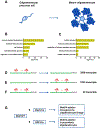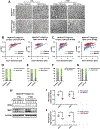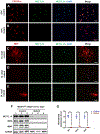m6A mRNA Methylation Is Essential for Oligodendrocyte Maturation and CNS Myelination
- PMID: 31901304
- PMCID: PMC7137581
- DOI: 10.1016/j.neuron.2019.12.013
m6A mRNA Methylation Is Essential for Oligodendrocyte Maturation and CNS Myelination
Abstract
The molecular mechanisms that govern the maturation of oligodendrocyte lineage cells remain unclear. Emerging studies have shown that N6-methyladenosine (m6A), the most common internal RNA modification of mammalian mRNA, plays a critical role in various developmental processes. Here, we demonstrate that oligodendrocyte lineage progression is accompanied by dynamic changes in m6A modification on numerous transcripts. In vivo conditional inactivation of an essential m6A writer component, METTL14, results in decreased oligodendrocyte numbers and CNS hypomyelination, although oligodendrocyte precursor cell (OPC) numbers are normal. In vitro Mettl14 ablation disrupts postmitotic oligodendrocyte maturation and has distinct effects on OPC and oligodendrocyte transcriptomes. Moreover, the loss of Mettl14 in oligodendrocyte lineage cells causes aberrant splicing of myriad RNA transcripts, including those that encode the essential paranodal component neurofascin 155 (NF155). Together, our findings indicate that dynamic RNA methylation plays an important regulatory role in oligodendrocyte development and CNS myelination.
Keywords: Mettl14; NF155; RNA epigenetic regulation; alternative splicing; m(6)A; mRNA methylation; myelin; oligodendrocyte development; oligodendrocyte precursor cells; oligodendrocytes.
Copyright © 2019 Elsevier Inc. All rights reserved.
Conflict of interest statement
Declaration of Interests
The authors declare no competing interests.
Figures








Similar articles
-
Sox2 Is Essential for Oligodendroglial Proliferation and Differentiation during Postnatal Brain Myelination and CNS Remyelination.J Neurosci. 2018 Feb 14;38(7):1802-1820. doi: 10.1523/JNEUROSCI.1291-17.2018. Epub 2018 Jan 15. J Neurosci. 2018. PMID: 29335358 Free PMC article.
-
Inward rectifying Kir4.1 channels regulate oligodendrocyte precursor cell differentiation and CNS myelination in vivo.Neurosci Lett. 2023 Jun 11;807:137278. doi: 10.1016/j.neulet.2023.137278. Epub 2023 Apr 26. Neurosci Lett. 2023. PMID: 37116573
-
PRRC2B modulates oligodendrocyte progenitor cell development and myelination by stabilizing Sox2 mRNA.Cell Rep. 2024 Mar 26;43(3):113930. doi: 10.1016/j.celrep.2024.113930. Epub 2024 Mar 18. Cell Rep. 2024. PMID: 38507412
-
Calcium Signaling in the Oligodendrocyte Lineage: Regulators and Consequences.Annu Rev Neurosci. 2020 Jul 8;43:163-186. doi: 10.1146/annurev-neuro-100719-093305. Epub 2020 Feb 19. Annu Rev Neurosci. 2020. PMID: 32075518 Review.
-
Glutamate versus GABA in neuron-oligodendroglia communication.Glia. 2019 Nov;67(11):2092-2106. doi: 10.1002/glia.23618. Epub 2019 Apr 7. Glia. 2019. PMID: 30957306 Review.
Cited by
-
m6A RNA methylation in brain injury and neurodegenerative disease.Front Neurol. 2022 Sep 8;13:995747. doi: 10.3389/fneur.2022.995747. eCollection 2022. Front Neurol. 2022. PMID: 36158961 Free PMC article. Review.
-
Advances in brain epitranscriptomics research and translational opportunities.Mol Psychiatry. 2024 Feb;29(2):449-463. doi: 10.1038/s41380-023-02339-x. Epub 2023 Dec 20. Mol Psychiatry. 2024. PMID: 38123727 Free PMC article. Review.
-
The epigenetic landscape of oligodendrocyte lineage cells.Ann N Y Acad Sci. 2023 Apr;1522(1):24-41. doi: 10.1111/nyas.14959. Epub 2023 Feb 5. Ann N Y Acad Sci. 2023. PMID: 36740586 Free PMC article. Review.
-
The Role of N6-Methyladenosine in Inflammatory Diseases.Oxid Med Cell Longev. 2022 Dec 12;2022:9744771. doi: 10.1155/2022/9744771. eCollection 2022. Oxid Med Cell Longev. 2022. PMID: 36578520 Free PMC article. Review.
-
Stage-specific control of oligodendrocyte survival and morphogenesis by TDP-43.Elife. 2022 Mar 21;11:e75230. doi: 10.7554/eLife.75230. Elife. 2022. PMID: 35311646 Free PMC article.
References
-
- Benjamini Y, and Yekutieli D (2005). False discovery rate–adjusted multiple confidence intervals for selected parameters. J. Am. Stat. Assoc 100, 71–81.
Publication types
MeSH terms
Substances
Grants and funding
LinkOut - more resources
Full Text Sources
Other Literature Sources
Molecular Biology Databases

